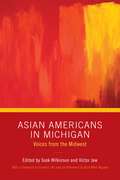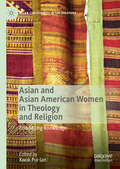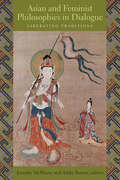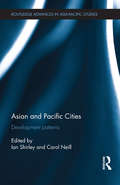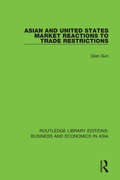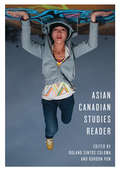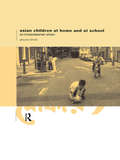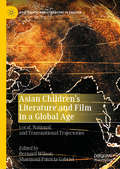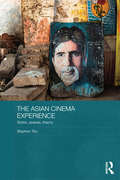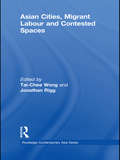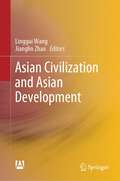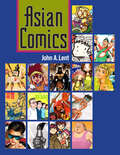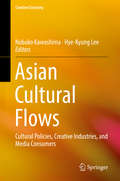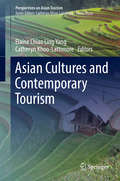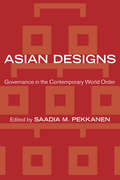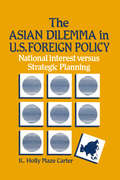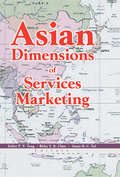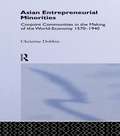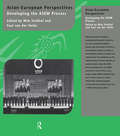- Table View
- List View
Asian Americans in Michigan: Voices from the Midwest (Great Lakes Books Series)
by Sook Wilkinson Victor JewWhile the number of Asians in Michigan was small for a good portion of the state's history, many Asian-derived communities have settled in the area and grown significantly over time. In Asian Americans in Michigan: Voices from the Midwest, editors Sook Wilkinson and Victor Jew have assembled forty-one contributors to give an intimate glimpse into Michigan's Asian-American communities, creating a fuller picture of these often overlooked groups. Accounts in the collection come from a range of perspectives, including first-generation immigrants, those born in the United States, and third- and fourth-generation Americans of Asian heritage. In five sections, contributors consider the historical and demographic origins of Michigan's Asian American communities, explore their experiences in memory and legacy keeping, highlight particular aspects of community culture and heritage, and comment on prospects and hopes for the future. This volume's vibrant mix of contributors trace their ancestries back to East Asia (China, Japan, Korea, Taiwan), South Asia (Bangladesh, India, Pakistan), and Southeast Asia (Cambodia, Laos, Philippines, Thailand, Vietnam, and the Hmong). Though each contributor writes from his or her unique set of experiences, Asian Americans in Michigan also reveals universal values and memories held by larger communities. Asian Americans in Michigan makes clear the significant contributions by individuals in many fields--including art, business, education, religion, sports, medicine, and politics--and demonstrates the central role of community organizations in bringing ethnic groups together and preserving memories. Readers interested in Michigan history, sociology, and Asian American studies will enjoy this volume.
Asian and Asian American Women in Theology and Religion: Embodying Knowledge (Asian Christianity in the Diaspora)
by Pui-Lan KwokThis book presents personal narratives and collective ethnography of the emergence and development of Asian and Asian American women’s scholarship in theology and religious studies. It demonstrates how the authors’ religious scholarship is based on an embodied epistemology influenced by their social locations. Contributors reflect on their understanding of their identity and how this changed over time, the contribution of Asian and Asian American women to the scholarship work that they do, and their hopes for the future of their fields of study. The volume is multireligious and intergenerational, and is divided into four parts: identities and intellectual journeys, expanding knowledge, integrating knowledge and practice, and dialogue across generations.
Asian and Feminist Philosophies in Dialogue: Liberating Traditions
by Jennifer McWeeny Ashby ButnorIn this collection of original essays, international scholars put Asian traditions, such as Hinduism, Buddhism, Daoism, and Confucianism, into conversation with one or more contemporary feminist philosophies, founding a new mode of inquiry that attends to diverse voices and the complex global relationships that define our world. These cross-cultural meditations focus on the liberation of persons from suffering, oppression, illusion, harmful conventions and desires, and other impediments to full personhood by deploying a methodology that traverses multiple philosophical styles, historical texts, and frames of reference. Hailing from the discipline of philosophy in addition to Asian, gender, and religious studies, the contributors offer a fresh take on the classic concerns of free will, consciousness, knowledge, objectivity, sexual difference, embodiment, selfhood, the state, morality, and hermeneutics. One of the first anthologies to embody the practice of feminist comparative philosophy, this collection creatively and effectively engages with global, cultural, and gender differences within the realms of scholarly inquiry and theory construction.
Asian and Pacific Cities: Development Patterns (Routledge Advances in Asia-Pacific Studies)
by Ian Shirley Carol NeillThe cities of Asia and the Pacific are at the epicentre of development in what is arguably, the most populous, culturally distinctive, and economically powerful region in the world. 16 major cities such as Tokyo, Shanghai, Manila, Jakarta, Bangkok, Singapore, Auckland, Kuala Lumpur and Santiago, located in countries as diverse as Mexico and Vietnam, Samoa and India, China and Australia, exemplify the changing patterns of development across this vast region of the world. By tracking economic and social trends the contributors to this collection reveal how a wide range of political and cultural factors have interacted over time to provide a powerful explanation for the shape and characteristics of ‘the city’ today. Based on a collaborative research programme and drawing on the work of local researchers, this book examines the realities of city development characterised by domestic migration, spatial and social fragmentation, squatter settlements and gated communities, economic experiments and the emergence of the ‘Asian Tigers’. The collection as a whole records the way in which countries in this region have moved from underdevelopment to become global economic and political powers. This book provides a fascinating journey through Asia and the Pacific by generating an insiders’ view of each city and an insight into national development. As such it will be of great interest to students and scholars interested in: the Asian and Pacific region; in disciplines such as economics, politics, geography and sociology; and in policy domains such as urban planning and economic development.
Asian and United States Market Reactions to Trade Restrictions (Routledge Library Editions: Business and Economics in Asia #3)
by Qian SunThe effect of US protectionist policy on stock prices of firms in the US and abroad is still an open question. This book, first published in 1996, investigates the effects of trade restrictions at the level of the individual firm, focusing on US, Taiwan and South Korea.
Asian Anthropology (Anthropology of Asia)
by Jan Van Bremen Eyal Ben-Ari Syed Farid AlatasAsian Anthropology raises important questions regarding the nature of anthropology and particularly the production and consumption of anthropological knowledge in Asia. Instead of assuming a universal standard or trajectory for the development of anthropology in Asia, the contributors to this volume begin with the appropriate premise that anthropologies in different Asian countries have developed and continue to develop according to their own internal dynamics. With chapters written by an international group of experts in the field, Asian Anthropology will be a useful teaching tool and a valuable resource for scholars working in Asian anthropology.
Asian-Cajun Fusion: Shrimp from the Bay to the Bayou (America's Third Coast Series)
by Carl A. Brasseaux Donald W. DavisShrimp is easily America’s favorite seafood, but its very popularity is the wellspring of problems that threaten the shrimp industry’s existence. Asian-Cajun Fusion: Shrimp from the Bay to the Bayou provides insightful analysis of this paradox and a detailed, thorough history of the industry in Louisiana. Dried shrimp technology was part of the cultural heritage Pearl River Chinese immigrants introduced into the Americas in the mid-nineteenth century. As early as 1870, Chinese natives built shrimp-drying operations in Louisiana’s wetlands and exported the product to Asia through the port of San Francisco. This trade internationalized the shrimp industry. About three years before Louisiana’s Chinese community began their export endeavors, manufactured ice became available in New Orleans, and the Dunbar family introduced patented canning technology. The convergence of these ancient and modern technologies shaped the evolution of the northern Gulf Coast’s shrimp industry to the present. Coastal Louisiana’s historic connection to the Pacific Rim endures. Not only does the region continue to export dried shrimp to Asian markets domestically and internationally, but since 2000 the region’s large Vietnamese immigrant population has increasingly dominated Louisiana’s fresh shrimp harvest. Louisiana shrimp constitute the American gold standard of raw seafood excellence. Yet, in the second decade of the twenty-first century, cheap imports are forcing the nation’s domestic shrimp industry to rediscover its economic roots. “Fresh off the boat” signs and real-time internet connections with active trawlers are reestablishing the industry’s ties to local consumers. Direct marketing has opened the industry to middle-class customers who meet the boats at the docks. This “right off the boat” paradigm appears to be leading the way to reestablishment of sustainable aquatic resources. All-one-can-eat shrimp buffets are not going to disappear, but the Louisiana shrimp industry’s fate will ultimately be determined by discerning consumers’ palates.
Asian Canadian Studies Reader
by Gordon Pon Roland ColomaRoland Sintos Coloma and Gordon Pon’s Asian Canadian Studies Reader brings together essential writings by leading and emerging scholars in the field to explore the vibrancy of the diverse Asian diaspora in Canada. The Reader is the perfect textbook for undergraduate courses in Race and Ethnic Studies, Women and Gender Studies, and Migration and Diaspora Studies. The volume is organized into four main themes: ethnic, intersectional, comparative, and transnational encounters. It critically engages topics regarding orientalism, settler colonialism, globalization, and nationalism. Each groundbreaking essay challenges our conventional understandings of diversity and multiculturalism by tackling the intricacies of racism and racialization. By capturing the rich diversity within Asian Canadian communities, Coloma and Pon dispel the perceptions of Asians as always immigrants, newcomers, or model minorities. The Asian Canadian Studies Reader is the first interdisciplinary collection of essays intended for undergraduate use about Canada’s largest racialized minority group.
Asian Children at Home and at School: An Ethnographic Study
by Ghazala BhattiThis book is an ethnographic study of a comprehensive school in the south of England. It explores the views of teachers, Asian parents and their children concerning education and schooling. Young people between the ages of 13 and 18 were studied at home and at school and their experiences form the main focus of the study.The experiences of fifty Pakistani, Bangladeshi and Indian families - mostly of Muslim faith - are studied with a view to discovering what parents expect from their children's school and how the teachers perceive their own role with regard to their students. These young people are the first generation of Asians to be educated in Britain. Their location in terms of their social class positions, gender and ethnicity are inextricably bound together. They describe how they see their past and their future. This is the first study to take account of boys and girls in order to capture the complexity of their lived experiences.
Asian Children’s Literature and Film in a Global Age: Local, National, and Transnational Trajectories (Asia-Pacific and Literature in English)
by Sharmani Patricia Gabriel Bernard WilsonThis volume provides a key analysis of Asian children’s literature and film and creates a dialogue between East and West and between the cultures from which they emerge, within the complex symbiosis of their local, national and transnational frameworks. In terms of location and content the book embraces a broad scope, including contributions related to the Asian-American diaspora, China, India, Indonesia, Iran, Japan, Malaysia, the Philippines, South Korea, Sri Lanka, and Taiwan. Individually and collectively, these essays broach crucial questions: What elements of Asian literature and film make them distinctive, both within their own specific culture and within the broader Asian area? What aspects link them to these genres in other parts of the world? How have they represented and shaped the societies and cultures they inhabit? What moral codes do they address, underpin, or contest? The volume provides further voice to the increasingly diverse and fascinating output of the region and emphasises the importance of Asian art forms as depictions of specific cultures but also of their connection to broader themes in children’s texts, and scholarship within this field.
Asian Cinema and the Use of Space: Interdisciplinary Perspectives (Routledge Advances in Film Studies)
by Edna Lim Lilian CheeAsian cinemas are connected to global networks and participate in producing international film history while at the same time influenced and engaged by spatial, cultural, social and political transformations. This interdisciplinary study forwards a productive pairing of Asian cinemas and space, where space is used as a discursive tool to understand cinemas of Asia. Concentrating on the performative potential of cinematic space in Asian films, the contributors discuss how space (re)constructs forms of identities and meanings across a range of cinematic practices. Cities, landscapes, buildings and interiors actively shape cinematic performances of such identities and their significances. The essays are structured around the spatial themes of ephemeral, imagined and contested spaces. They deal with struggles for identity, belonging, autonomy and mobility within different national and transnational contexts across East, Southeast and parts of South Asia in particular, which are complicated by micropolitics and subcultures, and by the interventions and interests of global lobbies.
The Asian Cinema Experience: Styles, Spaces, Theory (Media, Culture and Social Change in Asia)
by Stephen TeoThis book explores the range and dynamism of contemporary Asian cinemas, covering East Asia (China, Japan, South Korea, Hong Kong, Taiwan), Southeast Asia (Thailand, Singapore, Malaysia), South Asia (Bollywood), and West Asia (Iran), in order to discover what is common about them and to engender a theory or concept of "Asian Cinema". It goes beyond existing work which provides a field survey of Asian cinema, probing more deeply into the field of Asian Cinema, arguing that Asian Cinema constitutes a separate pedagogical subject, and putting forward an alternative cinematic paradigm. The book covers "styles", including the works of classical Asian Cinema masters, and specific genres such as horror films, and Bollywood and Anime, two very popular modes of Asian Cinema; "spaces", including artistic use of space and perspective in Chinese cinema, geographic and personal space in Iranian cinema, the private "erotic space" of films from South Korea and Thailand, and the persistence of the family unit in the urban spaces of Asian big cities in many Asian films; and "concepts" such as Pan-Asianism, Orientalism, Nationalism and Third Cinema. The rise of Asian nations on the world stage has been coupled with a growing interest, both inside and outside Asia, of Asian culture, of which film is increasingly an indispensable component – this book provides a rich, insightful overview of what exactly constitutes Asian Cinema.
Asian Cities, Migrant Labor and Contested Spaces (Routledge Contemporary Asia Series)
by Tai-Chee WongThis volume explores how migration is playing a central role in the renewing and reworking of urban spaces in the fast growing and rapidly changing cities of Asia. Migration trends in Asia entered a new phase in the 1990s following the end of the Cold War which marked the advent of a renewed phase of globalization. Cities have become centrally implicated in globalization processes and, therefore, have become objects and sites of intense study. The contributors to this book reflect on the impact and significance of migration with a particular focus on the contested spaces that are emerging in urban contexts and the economic, social, religious and cultural domains with which they intersect. They also examines the roles and effects of different forms of migration in the cauldron of urban change, from low-skilled domestic migrants who maintain a close engagement with their rural homes, to highly skilled/professional transnational migrants, to legal and illegal international migrants who arrive with the hope of transforming their livelihoods. Providing a mosaic of insights into the links between migration, marginalization and contestation in Asia’s urban contexts, Asian Cities, Migrant Labor and Contested Spaces will be of interest to students and scholars of Asian studies, migration studies, urban studies and human geography.
Asian City Crossings: Pathways of Performance through Hong Kong and Singapore
by Rossella Ferrari; Ashley ThorpeAsian City Crossings is the first volume to examine the relationship between the city and performance from an Asian perspective. This collection introduces "city as method" as a new conceptual framework for the investigation of practices of city-based performing arts collaboration and city-to-city performance networks across East- and Southeast Asia and beyond. The shared and yet divergent histories of the global cities of Hong Kong and Singapore as postcolonial, multiethnic, multicultural, and multilingual sites, are taken as points of departure to demonstrate how "city as method" facilitates a comparative analytical space that foregrounds in-betweenness and fluid positionalities. It situates inter-Asian relationality and inter-city referencing as centrally significant dynamics in the exploration of the material and ideological conditions of contemporary performance and performance exchange in Asia. This study captures creative dialogue that travels city-based pathways along the Hong Kong-Singapore route, as well as between Hong Kong and Singapore and other cities, through scholarly analyses and practitioner reflections drawn from the fields of theatre, performance, and music. This book combines essays by scholars of Asian studies, theatre studies, ethnomusicology, and human geography with reflective accounts by Hong Kong and Singapore-based performing arts practitioners to highlight the diversity, vibrancy, and complexity of creative projects that destabilise notions of identity, belonging, and nationhood through strategies of collaborative conviviality and transnational mobility across multi-sited networks of cities in Asia. In doing so, this volume fills a considerable gap in global scholarly discourse on performance and the city and on the production and circulation of the performing arts in Asia.
Asian Civilization and Asian Development
by Linggui Wang Jianglin ZhaoThis book focuses on the dialogues to improve the communication among Asian countries, which is contributed by world-wide experts from think-tanks, academia and governments. In this book, it involves the topics of Connotation and Evolution of Asian Civilization, Exchanges and Mutual Learning of Asian Civilization, Asian Civilization and Asian Development, Opportunities and Challenges Faced with Asian Civilization, etc.
Asian Comics
by John A. LentGrand in its scope, Asian Comics dispels the myth that, outside of Japan, the continent is nearly devoid of comic strips and comic books. Relying on his fifty years of Asian mass communication and comic art research, during which he traveled to Asia at least seventy-eight times and visited many studios and workplaces, John A. Lent shows that nearly every country had a golden age of cartooning and has experienced a recent rejuvenation of the art form. As only Japanese comics output has received close and by now voluminous scrutiny, Asian Comics tells the story of the major comics creators outside of Japan. Lent covers the nations and regions of Bangladesh, Cambodia, China, Hong Kong, India, Indonesia, Korea, Malaysia, Myanmar, Nepal, the Philippines, Singapore, Sri Lanka, Taiwan, Thailand, and Vietnam. Organized by regions of East, Southeast, and South Asia, Asian Comics provides 178 black-and-white illustrations and detailed information on comics of sixteen countries and regions—their histories, key creators, characters, contemporary status, problems, trends, and issues. One chapter harkens back to predecessors of comics in Asia, describing scrolls, paintings, books, and puppetry with humorous tinges, primarily in China, India, Indonesia, and Japan. The first overview of Asian comic books and magazines (both mainstream and alternative), graphic novels, newspaper comic strips and gag panels, plus cartoon/humor magazines, Asian Comics brims with facts, fascinating anecdotes, and interview quotes from many pioneering masters, as well as younger artists.
Asian Cultural Flows: Cultural Policies, Creative Industries, and Media Consumers (Creative Economy #0)
by Nobuko Kawashima Hye-Kyung LeeThis book investigates economic, political, and cultural conditions that have led to transnational flows of culture in Asia. Coverage also looks at the consequences of an increasingly interconnected Asian regional culture as well as policy makers and cultural industries' response to it. The book features essays written by researchers from different countries in Asia and beyond with diverse disciplinary backgrounds. The volume also contains engaging examples and cases with comparative perspectives.The contributors provide readers with grounded analysis in the organizational and economic logics of Asian creative industries, national cultural policies that promote or hinder cultural flows, and the media convergence and online consumers' surging demand for Asianized cultural products. Such insights are of crucial importance for a better understanding of the dynamics of transnational cultural flows in contemporary Asia. In addition, the essays aim to “de-westernize” the study of cultural and creative industries, which draws predominantly on cases in the United States and Europe. The contributors focus instead on regional dynamics of the development of these industries.The popularity of J-Pop and K-Pop in East and Southeast Asia (and beyond) is now well known, but less is known about how this happened. This volume offers readers theoretical tools that will help them to make better sense of those exciting phenomena and other rising cultural flows within Asia and their relevance to the global cultural economy.
Asian Cultures and Contemporary Tourism (Perspectives On Asian Tourism)
by Elaine Chiao Ling Yang Catheryn Khoo-LattimoreBrings together different perspectives to understand cultures that underpin contemporary Asian tourist behaviours.<P><P> Offers tourism researchers, students and practitioners a consolidated, comprehensive and updated reference for the understanding of Asian tourists.<P> Provides an intellectual platform for Asian scholars to represent the voices of Asian tourists in their own cultural terms.<P>This book focuses on cultures that shape contemporary Asian tourist experiences. The book consists of 10 chapters, which are organised into two themes: Collectivist Culture and Wellbeing. The chapters cover emerging forms of tourism (e.g., wedding and bridal photography tourism, roots/affinity tourism and shamanic tourism), investigate a wide range of topics (e.g., tourist motivation, tourist anxiety and decision making) and consider Asian perspectives from diverse backgrounds (e.g., China, Hong Kong, Singapore, Taiwan, South Korea, Japan, Philippines, Malaysia, Indonesia, India, Bangladesh, and Nepal). The book provides tourism researchers, students and practitioners a consolidated, comprehensive and updated reference for the understanding of Asian tourists.
Asian Department Stores (ConsumAsian Series #No. 4)
by Kerrie L. MacPhersonIn this pioneering study of the development of the Asian department store, economists, anthropologists and historians examine various aspects of retailing, business organization, networking and consumerism in the expanding economies of Asia.
Asian Designs: Governance in the Contemporary World Order
by Saadia PekkanenAsian nations are no longer "rising" powers in the world order; they have risen. How will they conduct themselves in world politics? How will they deploy their considerable and growing power individually and collectively? These questions are critical for global governance. Conventional wisdom claims that, lacking in institutions that accumulate and coordinate the massive economic and growing military strength of Asian nations, the Asian region will continue to punch below its weight in world politics; thin and patchy institutionalization results in political weakness. In Asian Designs, Saadia M. Pekkanen and her collaborators question and provide evidence on these core assumptions of Western scholarship. The book advances a new framework for debate and sophisticated examinations of institutional arrangements for several major issue areas in the world order—security, trade, environment, and public health.ContributorsVinod K. Aggarwal, University of California at BerkeleyC. Randall Henning, American University Keisuke Iida, University of TokyoPurnendra Jain, University of AdelaideDavid Kang, University of Southern California Saori N. Katada, University of Southern CaliforniaMin Gyo Koo, Seoul National UniversityKerstin Lukner, University of Duisburg-EssenTakamichi Tam Mito, Kwansei Gakuin UniversityJames Clay Moltz, Naval Postgraduate SchoolSaadia M. Pekkanen, University of WashingtonKim DoHyang Reimann, Georgia State UniversityKellee S. Tsai, Hong Kong University of Science and TechnologyMing Wan, George Mason University
The Asian Dilemma in United States Foreign Policy: National Interest Versus Strategic Planning
by K.Holly Maze CarterFocuses on the problem through the identification of specific trends in foreign policy: isolationism, intervention, containment, detente, and disengagement. The conclusion of this analysis is that the US foreign policy process is reactive and lacking in any long-term strategic planning mode. Paper e
Asian Dimensions of Services Marketing
by Esther Tang Ricky Chan Susan TaiExplore current trends in the Asian service industry!Asian Dimensions of Services Marketing takes you on a journey through the service industries of Asia. Due to the extraordinary amount of growth in Asian service industries over the past few decades, this sector is expanding greatly in many Asian countries. These changes have had many effects on countries such as China, Korea, Singapore, and Thailand, mostly at the expense of agriculture and manufacturing. This book examines these effects, and establishes ways to achieve success in services marketing. This educational book provides an enlightening look at topics such as: the influence of reference groups in the service industry of Singapore the moderating effect of switching costs on the relationship between service performance and customer satisfaction in the Thai cultural and business setting how multinational professional service firms in South Korea have achieved success the emotional impact of store atmosphere on Chinese customers in a leisure service setting the rapid development of services in Asia, and how to effectively market intangibles to various kinds of consumers
Asian Education Miracles: In Search of Sociocultural and Psychological Explanations (Routledge Series on Schools and Schooling in Asia)
by Gregory Liem Ser TanWith a focus on Asian contexts, this book brings together knowledge on how values and practices, embedded and practised in the classroom, school, family, and the society at large, can influence students’ motivation, engagement and psychological well-being. The book synthesizes research on students and systems from culturally diverse Asian countries and economies, including Cambodia, Hong Kong-China, Indonesia, Japan, Korea, the Philippines, Singapore, Chinese Taipei, Thailand, the United Arab Emirates, and beyond. The book takes special interest in applying the insights gained from understanding students’ motivation, engagement, and well-being within their sociocultural contexts. Importantly, chapters in the book are grounded on thorough theoretical reviews and sound empirical findings, which together inform practical applications to enhance the motivation, engagement, and well-being of students in the Asian region. Taken together, this book will serve as a comprehensive and authoritative source for scholars, researchers, and practitioners (teachers, school policy makers, and educators in general) who are interested in examining and enhancing student motivation, engagement, and well-being from Asian perspectives.
Asian Entreprenuerial Minorities: Conjoint Communities in the Making of the World Economy, 1570-1940
by Christine DobbinFirst Published in 1996. Routledge is an imprint of Taylor & Francis, an informa company.
Asian-European Perspectives: Developing the ASEM Process (Iias Asian Studies #Vol. 4)
by Wim Stokhof Paul van VeldeThe Asia-Europe Meeting (ASEM) is an interregional forum for political dialogue, education and culture, security and business, aimed at enhancing relations between Asia and Europe to achieve a better interregional balance in the spheres of politics, economics and culture. Its members are the seven ASEAN countries and the 15 EU countries. This book addresses three questions of central importance to the ASEM process and to the involvement of the private sector: What role can Europe and Asia play in managing an integrated global economy? What will be the role of the private sector in boosting the ASEM process? And how can the full potential of ASEM be realised? The contributors to the volume are Asian and European academics, politicians and businessmen who have been involved in the process from the very beginning.
